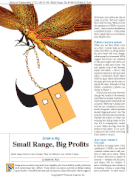Stocks & Commodities V. 32:2 (28-30, 40): Small Range, Big Profits by Robert E. Ross
Product Description
Small Range, Big Profits by Robert E. Ross
Small Is Big
Small-range bars are your friends. They’re talking to you. Listen to them.
Strong moves usually occur after low volatility, and low volatility usually shows up with small-range bars (SRBs). These SRBs can expose several profitable trading opportunities. In an SRB, the open and close price is almost the same, which suggests that buyers and sellers are almost equal in power. But don’t expect this to last for long. When you see the appearance of SRBs on a price chart —they’re easily identified on a candlestick chart — it may mean that a significant price movement may happen soon.
Trend change ahead
When you see these SRBs occur on a chart, consider them an indication that there’s a strong chance the price trend will soon change, either upward or downward. SRBs suggest that buyers are reluctant to take price higher and sellers are reluctant to take price lower. The bars signify a tug of war between buyers and sellers — that is, they represent indecision by buyers and sellers. Candlestick charts depict SRBs as dojis, which indicate that the open and close are the same or almost the same. Examples of doji (SRBs) candlestick patterns are shown in Figure 1.
If they occur near a top, the trend change will usually be downward, and if they occur near a bottom, the trend change would usually indicate an upturn. SRBs don’t always have tails but are sometimes accompanied by long tails, which represent the day’s high and/or day’s low. The position of the tail helps you decide whether the buyers or sellers are winning the trading battle for the day. If it’s a topping tail, control is most likely moving from the buyers to the sellers. If it’s a bottoming tail, the control is moving from sellers to buyers.
And then there’s volume
In addition to being aware of the appearance of SRBs, you should consider volume since it will confirm or deny price action. Think of volume and price as supply & demand — demand will be price, and supply will be volume. If price is heading up and volume is increasing, volume is supporting price movement. In other words, supply is supporting demand and the upward trend should continue. However, if price is rising but volume is falling, it means there is a divergence between price and volume. Volume is telling you that the trend is losing steam and a reversal in price may be imminent. Volume is signaling uncertainty at that price level.
Small Is Big
Small-range bars are your friends. They’re talking to you. Listen to them.
Strong moves usually occur after low volatility, and low volatility usually shows up with small-range bars (SRBs). These SRBs can expose several profitable trading opportunities. In an SRB, the open and close price is almost the same, which suggests that buyers and sellers are almost equal in power. But don’t expect this to last for long. When you see the appearance of SRBs on a price chart —they’re easily identified on a candlestick chart — it may mean that a significant price movement may happen soon.
Trend change ahead
When you see these SRBs occur on a chart, consider them an indication that there’s a strong chance the price trend will soon change, either upward or downward. SRBs suggest that buyers are reluctant to take price higher and sellers are reluctant to take price lower. The bars signify a tug of war between buyers and sellers — that is, they represent indecision by buyers and sellers. Candlestick charts depict SRBs as dojis, which indicate that the open and close are the same or almost the same. Examples of doji (SRBs) candlestick patterns are shown in Figure 1.
If they occur near a top, the trend change will usually be downward, and if they occur near a bottom, the trend change would usually indicate an upturn. SRBs don’t always have tails but are sometimes accompanied by long tails, which represent the day’s high and/or day’s low. The position of the tail helps you decide whether the buyers or sellers are winning the trading battle for the day. If it’s a topping tail, control is most likely moving from the buyers to the sellers. If it’s a bottoming tail, the control is moving from sellers to buyers.
And then there’s volume
In addition to being aware of the appearance of SRBs, you should consider volume since it will confirm or deny price action. Think of volume and price as supply & demand — demand will be price, and supply will be volume. If price is heading up and volume is increasing, volume is supporting price movement. In other words, supply is supporting demand and the upward trend should continue. However, if price is rising but volume is falling, it means there is a divergence between price and volume. Volume is telling you that the trend is losing steam and a reversal in price may be imminent. Volume is signaling uncertainty at that price level.
FOR THOSE ORDERING ARTICLES SEPARATELY:
*Note: $2.95-$5.95 Articles are in PDF format only. No hard copy of the article(s) will be delivered. During checkout, click the "Download Now" button to immediately receive your article(s) purchase. STOCKS & COMMODITIES magazine is delivered via mail. After paying for your subscription at store.traders.com users can view the S&C Digital Edition in the subscriber's section on Traders.com.
| Take Control of Your Trading. |
| Professional Traders' Starter Kit |
| All these items shown below only $430! |
| Click Here to Order |



